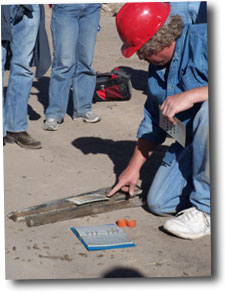 David M. Nielsen is President of Nielsen Ground-Water Science, Inc., the parent company of The Nielsen Environmental E-School and The Nielsen Environmental Field School. He is a Certified Professional Geologist (AIPG #5040), a Professional Hydrogeologist (AIH #991), a Certified Ground-Water Professional (AGWSE #179) and a Certified/Licensed/Registered Professional Geologist in 7 states (AK, AR, DE, FL, IN, SC, TX). He has 40 years of experience in ground-water and environmental consulting, training and research. He has managed ground-water contamination investigations, environmental site assessments, ground-water monitoring and sampling programs, petroleum hydrocarbon spill investigations and remedial projects across the U.S. David was one of the primary instructors for Princeton Groundwater's Groundwater Pollution and Hydrology Course for 12 years, and he has also developed curriculum for and instructed: undergraduate, graduate and continuing education courses in ground-water science at Wright State University; Technology Transfer workshops on Environmental Site Characterization and Ground-Water Monitoring and Sampling for the U.S. EPA; Waste Management, Inc.'s Landfill University; and a one-year Hydrogeologic Training Program for the Environmental Response Division of the Michigan Department of Environmental Quality. He has instructed more than 500 ground water and environmental science short courses and workshops for consulting firms, regulatory agencies, industrial concerns, the Department of Defense, the U.S. EPA, trade and professional organizations, educational institutes and universities in the U.S., England, Canada, Australia, Guatemala and Mexico.
David M. Nielsen is President of Nielsen Ground-Water Science, Inc., the parent company of The Nielsen Environmental E-School and The Nielsen Environmental Field School. He is a Certified Professional Geologist (AIPG #5040), a Professional Hydrogeologist (AIH #991), a Certified Ground-Water Professional (AGWSE #179) and a Certified/Licensed/Registered Professional Geologist in 7 states (AK, AR, DE, FL, IN, SC, TX). He has 40 years of experience in ground-water and environmental consulting, training and research. He has managed ground-water contamination investigations, environmental site assessments, ground-water monitoring and sampling programs, petroleum hydrocarbon spill investigations and remedial projects across the U.S. David was one of the primary instructors for Princeton Groundwater's Groundwater Pollution and Hydrology Course for 12 years, and he has also developed curriculum for and instructed: undergraduate, graduate and continuing education courses in ground-water science at Wright State University; Technology Transfer workshops on Environmental Site Characterization and Ground-Water Monitoring and Sampling for the U.S. EPA; Waste Management, Inc.'s Landfill University; and a one-year Hydrogeologic Training Program for the Environmental Response Division of the Michigan Department of Environmental Quality. He has instructed more than 500 ground water and environmental science short courses and workshops for consulting firms, regulatory agencies, industrial concerns, the Department of Defense, the U.S. EPA, trade and professional organizations, educational institutes and universities in the U.S., England, Canada, Australia, Guatemala and Mexico.
David is former Chairman of ASTM Subcommittee D-18.21 on Ground-Water and Vadose Zone Investigations, a consultant to the U.S. EPA Science Advisory Board, a member of the U.S. Department of Defense SERDP/ESTCP Peer Review Panel, and an advisor to the U.S. Department of Energy National Advanced Drilling and Excavation Technology Program. He is the editor and a contributing author for The Practical Handbook of Environmental Site Characterization and Ground-Water Monitoring (First and Second Editions; 1991 and 2006), The Essential Handbook of Ground-Water Sampling (2007) and Technical Guidance on Low-Flow Purging and Sampling and Minimum-Purge Sampling (2002). He is also a member of AIPG, the Association of Ground Water Scientists and Engineers, the American Institute of Hydrology and the Association of Engineering Geologists. He served for 12 years as Editor of Ground-Water Monitoring and Remediation and served for 12 years on the Wright State University Geology Department's Board of Counselors. He holds B.A. and M.S. degrees in geology from Miami University (1974) and Bowling Green State University (1977) respectively. Prior to co-founding The Nielsen Environmental Field School and Nielsen Ground-Water Science, Inc., he managed regional offices for two geoscientific and engineering consulting firms, served as Director of Research and Education for the National Ground Water Association and worked for state environmental agencies in Massachusetts, West Virginia and Ohio.
David has also written guidance documents on direct-push technology and ground-water sampling for the U.S. EPA Superfund program, and reviewed dozens of technical reports for the U.S. EPA's Environmental Technology Verification (ETV) program. He is the recipient of the Outstanding Service Award of the Association of Ground Water Scientists and Engineers, The Outstanding Achievement Award of ASTM, and a 4-time recipient of ASTM's Special Service Award.
